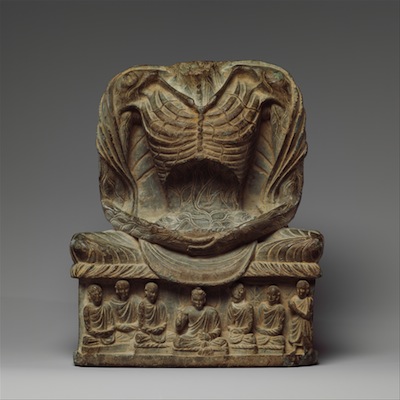A popular mudra in Buddhist art is the Abhaya mudra which symbolises protection peace and the. According to legend he was first exposed to Buddhist teaching when some monks cared for him after he was wounded in battle.

How The Buddha Got His Face The New York Times
These caskets drew visitors seeking a higher purpose and ultimately contributed to the proliferation of new forms of Buddhist art.

. 1 See answer mrsinghave8579 is waiting for your help. Click here to get an answer to your question What did Buddhist art rely on before the 1st century AD. The Mahabodhi Temple at Bodh Gaya became a model for similar structures in Burma and Indonesia.
Add your answer and earn points. Numerous religious sects arose in the middle Gangatic plains in the sixth century BC. One of his wives Devi was a Buddhist.
Before the 1st century AD Buddhist art relied on O A. Image source Wikimedia Commons. These arts took the form of votive tablets or friezes and were generally used as the decoration of stupas or Buddhist pilgrimage sites.
All three developed in India but Vajrayana was and still is primarily a Tibetan Buddhist practice and is usually discussed later in Survey IIArt and Architecture of India after 1200. Buddhist art originated in the Indian subcontinent in the centuries following the life of the historical Gautama Buddha in the 6th to 5th century BCE before evolving through its contact with other cultures and its diffusion through the rest of Asia and the world. The Rise and Spread of Buddhism before the first century AD.
A first essentially Indian aniconic phase avoiding direct representations of the Buddha was followed from around the. Iconic phase 1st century CE present. We hear of as many as 62 religious sects.
Date Event 383 BCE or c. The very first Buddhist artworks were stupas or caskets filled with Buddhas ashes after his death. The Second Buddhist council is convened by Kalasoka of the Shishunaga dynasty and held in VaishaliThe Sangha divides into the Sthaviravadins and the Mahasanghikas led by the monk Mahādeva primarily over the question of addition or subtraction of rules from the Vinaya.
The frescoes at Sigiriya are said to be even older than the Ajanta Caves paintings. Hindu art began to develop from the 1st to the 2nd century CE and found its first inspiration in the Buddhist art of Mathura. In the 2nd to 1st century BCE the buddhist arts were made representing episodes of the Buddhas life and teachings.
14th century To find out take 1st 2. The art in the times before the 1st century AD is called the Pre-iconic phase as it did not represent the face and bodily depictions of Buddha. Buddha statues O D.
The Nanda Empire briefly predominates in Magadha. The art was rich with Buddhist symbolism and Buddha presented through the abstract forms and symbols dharma wheel endless knot white parasol lotus. What century was it in 1314.
Sometimes spelled Asoka was a warrior-prince of India known for his ruthlessness. He was never depicted in the human form that we imagine today. Seated Bodhisattva Shakyamuni end of 1st century AD from Mathura.
Sold for 4250 via Madison Square Gallery July 2018. Of these sects Jainism and Buddhism were the most important and they emerged as the most potent religious reform movement. Chinese Cloisonne Enameled Bronze Buddhist Stupa.
Person2091 person2091 17102018 Sociology Secondary School. In China it is widely believed that Buddhist arrived around 1st Century AD. In the area known as Gandhara artistic elements from the Hellenistic world combined with the symbolism needed to express Indian Buddhism to create a unique style.
2 on a question Before the 1st century AD Buddhist art relied on O A. Mrsinghave8579 mrsinghave8579 17102018 Sociology Secondary School answered What did Buddhist art rely on before the 1st century AD. The earliest works of Buddhist art in India date back to the 1st century BCE.
The Emperor Ashoka. It progressively incorporated a profusion of original Hindu stylistic and symbolic elements in contrast with the general balance and simplicity of Buddhist art. In the first century AD the human image of one Buddha came to dominate the artistic scene and one of the first sites at which this occurred was along Indias northwestern frontier.
Before the 1st century AD Buddhist art relied on what. Buddha statues O D. In each phase changes to the Buddhist catechism were made and the.
One of Buddhisms earliest artistic inventions was the stupa a shrine in the form of a building that was not designed to be entered but. In this phase the Buddha was represented through symbols.

Pin On Verses From The Holy Quran

Pin On Gladiator Armour And Weapons Only Historically Accurate

Padampani Ajanta Caves Ajanta Caves Ancient Indian Architecture Buddha Painting

How The Buddha Got His Face The New York Times

Buddhist Art And Architecture Oxford Research Encyclopedia Of Asian History

Saint Vitus Patron Saint Of Dogs Religieuze Kunst Huisdieren Dansers


0 comments
Post a Comment